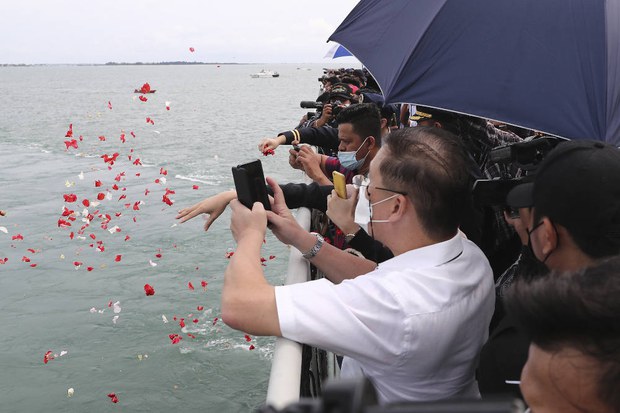Indonesian Crash Investigators: Sriwijaya Air Jet Had Problems with Automatic Throttle
2021.02.10
Jakarta
 Relatives of people who died in the crash of Sriwijaya Air flight 182 throw flowers into the Java Sea where the plane went down on Jan. 9, during a memorial ceremony held on the deck of Indonesian Navy Ship KRI Semarang, near Jakarta, Jan. 22, 2021.
Relatives of people who died in the crash of Sriwijaya Air flight 182 throw flowers into the Java Sea where the plane went down on Jan. 9, during a memorial ceremony held on the deck of Indonesian Navy Ship KRI Semarang, near Jakarta, Jan. 22, 2021.
An Indonesian passenger jet that plummeted into the sea last month, killing all 62 people on board, had problems with its automatic throttle system, investigators said Wednesday as they announced findings so far into the crash.
The left-engine throttle lever on the Boeing 737-500 moved backward, causing the engine to have less power and the Sriwijaya Air plane to roll onto its side before it crashed on Jan. 9, said Nurcahyo Utomo, the chief investigator at Indonesia’s National Transportation Safety Committee (KNKT).
“Both throttle levers experienced anomalies. The left side moved too far back, while the right one didn’t move, as if it was stuck,” Nurcahyo said during a press conference in Jakarta.
“We are still investigating what went wrong because there are 13 components connected to the throttle,” he told reporters, adding that some parts had been sent to Boeing, the aircraft’s manufacturer in the United States, for investigation.
The 26-year-old aircraft operated by Sriwijaya Air, a budget carrier, vanished from radar about four minutes after taking off from Soekarno-Hatta International Airport, and plummeted into Java Sea waters near the Indonesian capital, Jakarta.
Sriwijaya Air flight 182 was en route from Jakarta to Pontianak, the capital of West Kalimantan province on Borneo Island, when it crashed.
The pilot’s last radio contact with air-traffic controllers was when the crew responded to an instruction to climb to 13,000 feet, Nurcahyo said.
The flight-data recorder showed the plane had reached an altitude of 10,900 feet and then started descending, he said.
Pilots on earlier flights had reported that the throttle system had malfunctioned on Jan. 3 and 4, but those problems had been reported as successfully fixed, Nurcahyo said.
During the previous month, an airspeed indicator on the plane had been replaced after being damaged, he said.
Teams from the U.S. National Transportation Safety Administration and the Federal Aviation Administration have joined the investigation.
A full report on the crash is expected early next year.
Cockpit voice-recorder still missing
Investigators are still searching underwater for memory data from the cockpit voice-recorder (CVR) but poor weather in recent days had hampered the operation, said KNKT chairman Soerjanto Tjahjono.
Investigators were unable to come up with the cause of the crash without clear and supporting evidence, he said.
“Data are far from sufficient because the CVR has not been found,” Soerjanto told reporters.
Meanwhile, an aviation expert at the Indonesian Pilots Federation, M. Ali Nahdi, said he suspected that other factors had contributed to the crash.
“There must be other problems and faults, and the cause cannot be solely attributed to the automatic throttle system,” he told BenarNews.
He said the investigation could take a long time as there was no sufficient data.
“It would be great if the CVR could be found so that they have more complete data,” he said.
Another aviation analyst, Gerry Soejatman, agreed that other factors must have played a role in the crash. The pilots could have turned off the automatic throttle system and switched it to manual operation, he noted.
“Pilots are trained to pay attention to this and prevent loss of control,” Gerry told BenarNews.
“The plane rolled to the left slowly and maybe the crew was not aware of this. Were they busy doing something else? This should be investigated,” he said.
The plane that crashed had been grounded for nearly nine months last year as airlines cut flights during the coronavirus pandemic.
But the Transportation Ministry said that the Boeing 737 had undergone inspections before resuming flights in December.
The accident was the fourth major air crash in Indonesia during the past six years.
In October 2018, a Boeing 737 MAX belonging to Indonesia’s largest budget carrier, Lion Air, crashed into the Java Sea, killing all 189 people on board.
The aircraft’s faulty new anti-stall system was blamed for the crash, as well as that of another 737 Max in Ethiopia that killed 157 people in March 2019.
In June 2015, 139 people were killed, including 17 on the ground, when an Indonesian Air Force transport plane crashed near the Medan-Saewondo Air Base.
Indonesia, the world’s largest archipelagic nation, experienced a boom in low-cost carriers after the aviation industry was deregulated in the early 2000s.
In 2018, the European Union lifted a ban on Indonesian airlines, which was imposed in 2007 after a string of deadly air accidents.
Several Indonesian airlines, including flag carrier Garuda, were taken off the EU’s banned list back in 2009 after steps were taken to improve safety.
In 2017, the International Civil Aviation Organization ranked Indonesia’s aviation safety as above the global average, with a compliance rate of 81.15 per cent.







